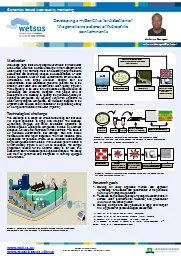

for detection of the genotoxic potency of hydrophilic contaminants Genomics based water quality monitoring antoinekarengerawetsusnl wwwwetsuseu wwwwageningenurnlmae Motivation Knowledge gaps related to hydrophilic chemicals in groundwater and surface water are a critical challenge i ID: 926684
Download Presentation The PPT/PDF document "Developing a HyGenChip" is the property of its rightful owner. Permission is granted to download and print the materials on this web site for personal, non-commercial use only, and to display it on your personal computer provided you do not modify the materials and that you retain all copyright notices contained in the materials. By downloading content from our website, you accept the terms of this agreement.
Slide1
Developing a HyGenChip for detection of the genotoxic potency of hydrophilic contaminants
Genomics based water quality monitoring
antoine.karengera@wetsus.nl
www.wetsus.euwww.wageningenur.nl/mae
MotivationKnowledge gaps related to hydrophilic chemicals in groundwater and surface water are a critical challenge in the management of water quality [1,2]. Currently, there is no existing proper method to concentrate and chemically analyze low concentrations of water soluble pollutants. Most of these contaminants remain unseen, unmeasured, and largely unknown. Despite their low concentrations, these substances present a potential risk to the drinking water chain and environmental water quality (Figure1). This especially is the case for very sensitive endpoints such as genotoxicity and endocrine disruption. This project aims at development of a bioassay to quantify the genotoxic potency of hydrophilic compounds. By exposing very small organisms to water with hydrophilic compounds, the molecular response in the organisms can be used as an indication of the genotoxic potency of compound mixtures in the water (Figure 2). Technological challenge The challenge is to design an efficient and cheap test that does not require specialists to apply and interpret. The bioassay, HyGenChip, employs very small invertebrate organisms as sentinel species. Hydrophilic compounds, invisible by chemical analyses, will leave their signature in those animals. The focus is on genotoxic contaminants that damage DNA and induce metabolic and DNA repair responses. The most indicative gene expressions for genotoxic effects will be validated with standard single compounds and mixtures. With selected gene markers a MAGPIX assay (Figure 3 & 4) will be developed. The sample preparation needed for the MAGPIX assay is far less time consuming than for classical gene expresion analyses. The assay can then be performed and interpreted in normally equipped laboratories.
Research goals Develop an easily applicable method and approach ‘HyGenChip’ for detection and quantification of the genotoxic potency of hydrophilic pollutants;To assess the genotoxic potency of hydrophilic contaminants in surface water (environmental relevance) and groundwater (source of raw drinking water); Develop a simple and easy procedure to apply and interpret the approach for genotoxicological assessment. [1] Loos, R., et al. Water Res 47 (2013): 6475-6487 [2] Lopez, B. et al. Sci. Total Environ. 518–519 (2015): 562–573[3] Nuwaysir, E.F. Et al. Mol Calcinog 24 (1999): 153-159[4] S. Angeloni, R. Cordes, S. Dunbar et al. (2016), xMAP Cookbook, 3rd edition, 2014, http://www.luminexcorp.com
Antoine Karengera
Antoine Karengera, MSc.Prof. Dr. Tinka Murk; Dr. Inez Dinkla; Ing. Marije IJszenga
Figure 1. Schematic representation of some possible sources of hydrophilic contaminants and their pathways to groundwater and surface water
Exposure to toxicant
RNA isolation
Hybridization on DNA microarray (DNA Chip)
Gene Expression Analysis
c
DNA synthesis
Magplex beads
Coupling oligonucleotides to the surfce of beads
Hybridization assay of target genes
in sample
Gene expression d
ata analysis
Read sample by using MagPix system to check the presence of target genes
Figure 4
. Schematic representation of multiplex assay
with the Magpix
system for gene expression profing
[4]
.
Figure 3
. Schematic representation summerizing the concept
of a DNA
microarray method. This assay provides the possibility to monitor the expression levels of thousands of genes simultaneously
[3]
.
Figure 2.
Graphical Abstract of the project
Bioassay for detection of genotoxic potency of hydrophilic contaminants
Exposure of model animal to genotoxins
Selection of gene
markers
for
genotoxicity
Development of
a MagPix
test based on
selected gene markers
(Bead-based test)
H
2
O
Contaminated water samples